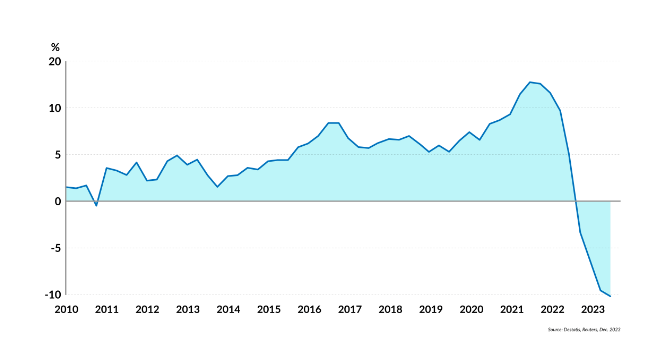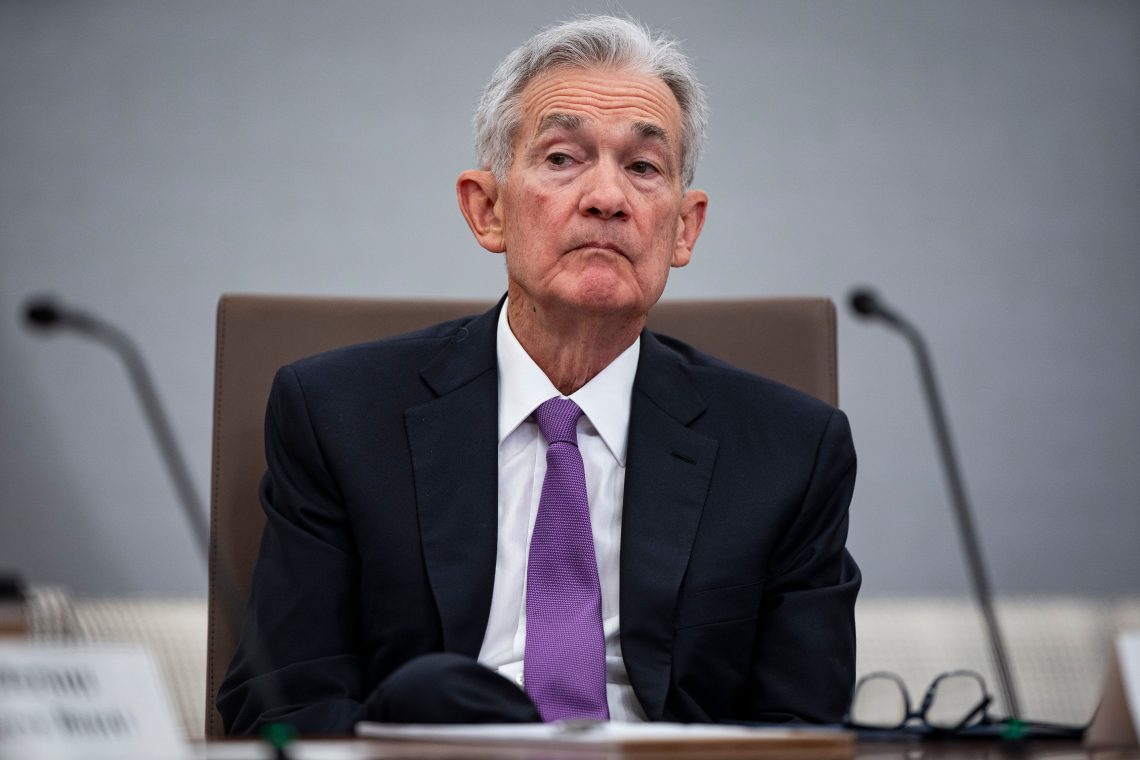Why Western governments may opt
to sit out the crisis in real estate
As the first-half mark of this decade approaches, global policymakers are striving to project optimism. Growth rates are low but still positive, they say. Central bankers created inflation but have largely succeeded in taming it. Job vacancies are soaring, and unemployment rates are nothing to worry about. Finally, in many advanced countries, public indebtedness is heavy, but the authorities are refinancing it with relative ease, and public expenditures keep flowing.
Fair enough, there are some causes for long-term concern: poor education, rising protectionism and the dislocations associated with new technologies are all things to keep an eye on. Yet, nobody seems overly disquieted. Instead, if one had to point out a significant, immediate “problem sector” shared by many large economies, that would be the real estate market.
The events that characterized the Chinese real estate situation during the past year have alarmed producers, households and policymakers worldwide. The Chinese crash was not a surprise, and it presents some unique features.
Beijing has been manipulating the construction industry since economic growth started declining. The authorities resorted to subsidies, easy credit and public investments to promote the supply of housing and office space, regardless of demand. While the gross domestic product (GDP) figures recorded these activities as “investments,” and losses were hidden by resorting to “creative” accounting practices, bad business ultimately drained liquidity. No rents, no sales and rising maintenance costs led to disaster.
The mismatch in the residential market is likely to persist unless the mortgage rates drop a couple of percentage points.
Construction companies went bankrupt, embarrassing provincial governments and causing vast suffering among shareholders and creditors, including banks and insurance companies. In this case, there will be no “soft landing” (a slowdown that avoids a recession) or “buying the dips” (purchasing an asset after it has dipped in price) that comes to the rescue. There is no end in sight to the decline in Chinese real estate. Domestic and foreign investors are scared, and many have moved their assets to stocks or stopped putting their money in the sinking boat under China’s flag.
Real estate trouble in America
Meanwhile, Western real estate markets are also in trouble, but for different reasons. In the United States, the residential segment suffers from a combination of high prices and expensive mortgages. Owners are not in a hurry to sell. Stopping them can be the significant capital gains made on the stock market during the past decade, or the high prices they paid initially to purchase the property. Potential buyers, meanwhile, hesitate to borrow at the rate charged currently by lenders (at least 7 percent). The mismatch in the residential market is likely to persist unless the mortgage rates drop a couple of percentage points.
Facts & figures
Office spaces present a different picture: nearly 20 percent of the space available stands empty. The 2020 pandemic induced seemingly now engrained work-from-home patterns; high commuting costs and companies’ efforts to make good use of technologies to economize have contributed to the reshaping of this segment of the industry. As a result, demand for office space has dipped while a construction boom (triggered by ultra-low interest rates in previous years) has inflated supply. The mismatch has now clearly manifested and will persist even if interest rates drop.
Housing and office space pain in Europe
Europe’s gloom comes from a different set of factors. The crisis that characterized the real estate market there in 2022-2023 was caused by higher interest rates and depressed real incomes for vast segments of the population. Two consequences followed: high-income investors moved from real estate to bonds, while middle- and low-income households are unwilling to borrow and purchase. In other words, supply was not exceptionally high, but demand was low, so prices fell across the board.
Facts & figures
German construction activity

This was particularly evident in Germany, which had experienced a boom in construction – both residential and office space – until 2022. The same happened in France and other European countries where higher interest rates and expectations for easier credit conditions encouraged a wait-and-see attitude. As a result, the 2023 prices in Europe declined sharply: 54 percent for residential housing and over 60 percent for office space. Not surprisingly, investment in the industry has collapsed.
Facts & figures
Investment in commercial real estate in Europe

Elementary economics
To summarize, the global real estate market has suffered from a classic supply-demand mismatch, with the former inflated and the latter weak. During the past decade, supply expanded thanks to easy money and various forms of subsidies and guarantees (particularly in China). The demand followed but then fell in 2022 and 2023 due to high interest rates, lower disposable real incomes dented by inflation and high taxation, uncertainty about future growth (which affects households’ ability to service their debts) and companies’ cost-cutting. Should the authorities worry?
The crisis has its roots in the buoyant decade when the monetary authorities did “whatever it took” to finance rising government expenditures and sustain economic activity despite a tightening regulatory straitjacket on enterprises and low productivity growth. The emphasis differs across countries, but the nature of the drivers is the same.
Scenarios
One can hope that the authorities have learned from the lessons of recent years and will abstain from trying to bring the real estate market back to equilibrium. Adjustment is not around the corner. However, we predict that, in most cases – and in absence of governmental intervention – demand for residential space will catch up to supply before the end of 2025.
Most likely: Western governments opt to sit out this crisis
Prices will stabilize and, sooner than expected, may bounce back in some areas. Upmarket buyers, for example, do not suffer from liquidity constraints. Once the fight against inflation is over, interest rates have declined and the monetary authorities have rebuilt their credibility, these buyers will be the first ones to jump at the new opportunities.
Demand in the lower end of the residential market, however, will hinge on the dynamics of households’ purchasing power. If tax pressure remains high and growth in the private sector stagnates – the most likely scenario for Europe – it will take some time before the middle class moves back into real estate and accepts the fact that mortgage rates will not return to where they were during the years of generous monetary policy.
A different scenario surfaces if the authorities decide that the disequilibrium requires their intervention, even though they have created the real estate problems in the first place and stood in the way of market adjustment. Of course, generalizations can be misleading. Yet, one can predict that, in some countries, the leading candidate for government intervention is office space.
Certain: Beijing’s unpalatable choice
China is a case to watch. Two options are available to its policymakers. As China’s economic activity is not likely to be vibrant enough to lead to the absorption of excess supply any time soon, the government may decide to let the construction industry rot. However, the Communist Party of China would suffer damage to its image as the creator and guardian of the country’s prosperity. Alternatively, Beijing may opt to nationalize most of the industry, spend large amounts of money on transforming at least part of the empty buildings into residential use and then sell them at fire-sale prices. Neither option is appealing, but there seems to be no alternative.
In Western economies, the problem is less daunting, and the temptation to intervene is weaker – unless the parties in power begin to believe that an excess supply problem should be solved by subsidizing demand. If so, new distortions would add to those already at work.
Likely: Letting the losers hang
The monetary authorities in the U.S. or the eurozone will likely abstain from using monetary policy to stimulate demand for housing and office space also for doctrinal reasons. Western policymakers tend to believe that the solution to any economic mismatch is boosting the side that is quantitatively deficient – in this case, it is the demand.
However, this time, central bankers assume that adjustment in the real estate market is not far away, and prices will tank before the year’s end. Also, today’s economic growth, mediocre as it may be, is not suffering from the weight of sick real estate, and measures designed to encourage households and companies to acquire more housing or office space would do little to improve the picture. In fact, they could even prove counterproductive. Lastly, the crisis in the real estate industry has no systemic impact.
































